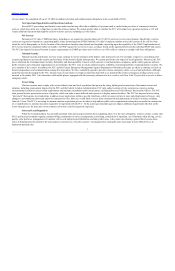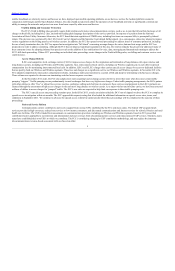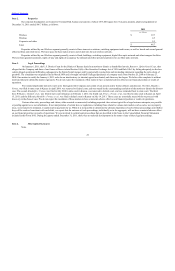Sprint - Nextel 2011 Annual Report Download - page 19
Download and view the complete annual report
Please find page 19 of the 2011 Sprint - Nextel annual report below. You can navigate through the pages in the report by either clicking on the pages listed below, or by using the keyword search tool below to find specific information within the annual report.
Table of Contents
the technology. Deployment of technology supporting new service offerings may also adversely affect the performance or reliability of our networks with respect to both
the new and existing services and may require us to take action like curtailing new subscribers in certain markets. Any resulting subscriber dissatisfaction could affect our
ability to retain subscribers and have an adverse effect on our results of operations and growth prospects.
Our wireless networks currently provide services utilizing CDMA and iDEN technologies. Wireless subscribers served by these two technologies represent a
smaller portion of global wireless subscribers than the subscribers served by wireless networks that utilize Global System for Mobile Communications (GSM) technology.
As a result, our costs with respect to both CDMA and iDEN network equipment and devices may continue to be higher than the comparable costs incurred by our
competitors who use GSM technology, which places us at a competitive disadvantage. See “The success of our network modernization plan, Network Vision, will depend
on the timing, extent and cost of implementation; the performance of third-parties and related parties; upgrade requirements; and the availability and reliability of the
various technologies required to provide such modernization.”
We have expended significant resources and made substantial investments to deploy a 4G mobile broadband network through our equity method investment in
Clearwire using WiMAX technology. As part of Network Vision, we announced that we currently intend to continue selling WiMAX devices through 2012 and that we
expect to continue to support such devices for a period of time after that, as we transition to LTE. The failure to successfully design, build and deploy our LTE network, or
a loss of or inability to access Clearwire's spectrum could increase subscriber losses, increase our costs of providing services or increase our churn. Other competing
technologies may have advantages over our current or planned technology and operators of other networks based on those competing technologies may be able to deploy
these alternative technologies at a lower cost and more quickly than the cost and speed with which Clearwire provides 4G MVNO services to us or with which we deploy
our LTE network, which may allow those operators to compete more effectively or may require us and Clearwire to deploy additional technologies. See “Risks Related to
our Investment in Clearwire” below for additional risks related to our investment in Clearwire and the operation of its 4G network.
Current economic and market conditions, our recent financial performance, our high debt levels, and our debt ratings could negatively impact our access to the
capital markets resulting in less growth than planned or failure to satisfy financial covenants under our existing debt agreements.
We expect to incur additional debt in the future for a variety of reasons, such as Network Vision and working capital needs, including equipment net subsidies,
future investments or acquisitions. Our ability to arrange additional financing will depend on, among other factors, current economic and market conditions, our financial
performance, our high debt levels, and our debt ratings. Some of these factors are beyond our control, and we may not be able to arrange additional financing on terms
acceptable to us or at all. Failure to obtain suitable financing when needed could, among other things, result in our inability to continue to expand our businesses and meet
competitive challenges, including implementation of Network Vision on our current timeline.
The continued instability in the global financial markets has resulted in periodic volatility in the credit, equity and fixed income markets. This volatility could
limit our access to the credit markets, leading to higher borrowing costs or, in some cases, the inability to obtain financing on terms that are acceptable to us, or at all.
We have incurred substantial amounts of indebtedness to finance operations and other general corporate purposes. We expect to incur additional amounts of
indebtedness in the future, which may be substantial. At December 31, 2011, the carrying value of our total debt was approximately $20.3 billion. As a result, we are
highly leveraged and will continue to be highly leveraged. Accordingly, our debt service requirements are significant in relation to our revenues and cash flow. This
leverage exposes us to risk in the event of downturns in our businesses (whether through competitive pressures or otherwise), in our industry or in the economy generally,
and may impair our operating flexibility and our ability to compete effectively, particularly with respect to competitors that are less leveraged.
The debt ratings for our notes are currently below the "investment grade" category, which results in higher borrowing costs than investment grade debt as well
as reduced marketability of our debt. Our debt ratings could be further downgraded for various reasons, including if we incur significant additional indebtedness, or if we
do not generate sufficient cash from our operations, which would likely increase our future borrowing costs and could adversely affect our ability to obtain additional
capital.
17
























